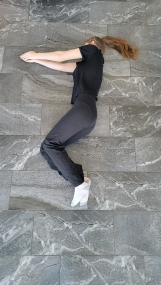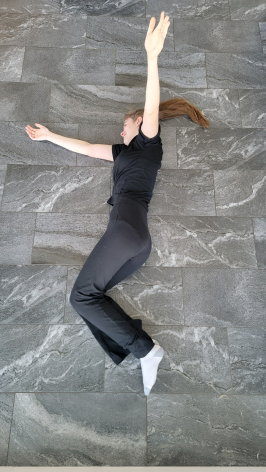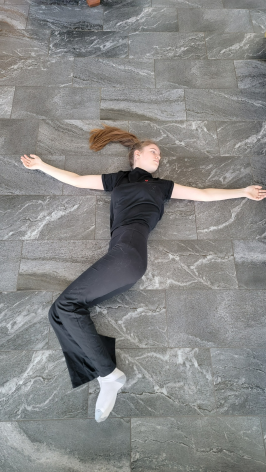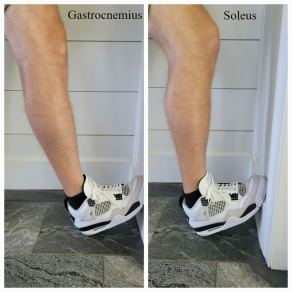Open Book Exercise
By Dr. Julie Hawthorne Adamski
January 2023
Does your mid-back feel tight? Are your shoulders and chest muscles tight? Do you hold stress in your thoracic spine and shoulders? If so, the open book exercise is an activity for you. This exercise is great for tennis players, golfers, and those that hold their stress at their mid-back.
The open book exercise opens and mobilizes the spine, mostly at the mid-back thoracic region. This exercise stretches the pectoralis muscles of the chest and anterior shoulder. Feel the open book exercise in all three areas or just in your most limited area.
When performing the open book exercise, keep in mind to move your trunk and rib cage and not just your arm. Try to keep your hips stacked. Breathe normally. You can pause at the end range of motion or choose to hold the exercise for approximately 30 seconds. Can perform the exercise with diaphragmatic breathing. As always, do not increase your pain.
OPEN BOOK EXERCISE
- Lie on your side with knees bent and arms stacked out front.
- Raise your top hand toward the ceiling.
- Continue to open the book where you are looking over your shoulder.
- Your head, rib cage, and top shoulder follow your moving hand. Hips are stationary.
Dr. Julie Hawthorne Adamski is a licensed physical therapist and the owner of Energy Physical Therapy LLC. Dr. Adamski serves the greater Pottstown and Boyertown area and is a local resident committed to the health and wellbeing of residents. Information in these tips is intended for educational use only. You should seek medical advice from your individual physical therapist or physician if needed. www.energy-pt.com 610-310-0915
Plantar Fasciitis and Heel Pain
By Dr. Julie Hawthorne Adamski
Oct/Dec 2022
Do you experience pain at the bottom of your foot with the first few steps in the morning? Plantar fasciitis is notorious for heel or arch pain that can cause you to limp in the morning. Besides AM pain, plantar fasciitis is typically alleviated mid-day but then worsens as you fatigue through the end of the day.
Plantar fasciitis is the degeneration of the band or fascia, that is located from your heel to the base of your toes. Degeneration alone is not the cause of plantar fasciitis. Degeneration changes of the fascia combined with overuse or poor training habits, change of surface, poor shoe wear, or change of shoe wear may affect your flexibility of foot and calf muscles, all of which can aggravate and strain the fascia and can cause pain.
You can walk around for years with degenerative plantar fascia but be perfectly fine until the behavioral changes negatively affect you and then have heel and arch problems. For example, your feet can feel great, and your typical behavior is to walk ½ mile every day in your neighborhood donning your regular sneakers. Then you go to the beach; the sun is shining, life is good, and you decide to walk barefoot on the beach for 3 miles without shoes on, in the soft wet sand. The next day you wake up and wonder why you have difficulty walking to the bathroom with immense foot and heel pain. Your body was not used to walking 3 miles, without shoes, and on a very soft surface.
What can you do about plantar fasciitis? The first thing is to be smarter about your behavior, especially if you have a history of plantar fasciitis in your past, as your feet are sensitive to behavioral changes. To prevent plantar fasciitis aggravation, consider your average behavior to the desired behavior. Drastic changes in behavior that may affect plantar fasciitis are:
- average steps/day and steps/week
- distance/length
- surface
- shoe wear
My 2 favorite stretches for heel and arch pain are calf stretches that address the gastrocnemius and soleus to help take the strain off the plantar fascia. Standing next to a wall, keep the heel on the ground, the front of your foot placed on the wall, and your hips leaning into the wall to determine the intensity of the stretch in your calf. The intensity should be light to medium, never pain. For the gastrocnemius stretch, keep the knee straight when you stretch your calf against the wall. The soleus stretch, the knee is bent, and you will feel the stretch lower towards your Achilles tendon.
Stretch around 30 seconds a few times per session. Stretch more gently in the AM because you do not want to re-aggravate the plantar fascia, stretch frequently throughout the day, and most at night.
Dr. Julie Hawthorne Adamski is a licensed physical therapist and the owner of Energy Physical Therapy LLC. Dr. Adamski serves the greater Pottstown and Boyertown area and is a local resident committed to the health and wellbeing of residents. Information in these tips is intended for educational use only. You should seek medical advice from your individual physical therapist or physician if needed. www.energy-pt.com 610-310-0915
Sit to Stand with Control: Squat Progression
By Dr. Julie Hawthorne Adamski
Aug/Sept 2022
Does it take multiple attempts to get out of your chair? Do you sit down gracefully, like a queen, or plop into your chair? Does your recliner keep scooting back against the wall? Difficulty getting out of a chair and lack of control with descent into a chair demonstrates weakness in the quadriceps and knees. Plopping into a chair is not graceful and can cause of the moving recliner. We can improve sit to stand from a chair with strength training. Squats are a great way to strengthen your thighs to help get you out of that chair on the first try or into that chair with control and grace.
Divide the squat into 3 versions which are easy, medium, and challenging. Master the easy version first and aim for perfect form. That may take a few days to a few weeks. Once you have perfect form, add in the medium version. You may need to compensate temporarily by using your hands to assist ascent and descent from a chair. Try using a mirror to watch your form, video yourself, or watch your knees by looking down. Slowly lose the compensation techniques so you can perfect the exercise with no help. Then you are ready for the harder version. Once mastered, you can choose to do all three versions.
Exercise should NOT increase your pain, but you will feel you are doing work in your knees and thighs, otherwise you are not building muscle. Perform 3x/week non-consecutive days. Start with a goal of 5 repetitions, then progress to 2 sets of 10. Grade yourself. Goal is perfect A+ form to progress to next level.
Consistency equals success. Everyone has bad days. If you have progressed to the hard version but have a bad day, down shift to an easier version to keep consistent with exercise.
Squat Progression: easy, medium, challenging.
1. Mini Squat or Top Half Squat. Start standing. You may use your hands or balance if needed. Squat down to barstool height or 1/2 the distance to a standard chair, then stand back up. Repeat.
2. Full Sit to Stand. Start seated and stand up straight. Repeat. Goal is traditional chair height to full standing without use of hands. May need to use a compensation techniques to get to that goal over time. Example of a compensation technique is using fingertips vs entire hand to assist perfect motion.
3. Bottom Half Squat. Start seated. Rise 1/2 the distance in a slow count of 3 seconds and descend in a slow count of 3 seconds. This focuses on the hardest part of sit to stand and this is where most people plop or lose control. Use temporary compensation technique of fewer repetitions or a change in speed to allow for perfect form.
These 3 versions of the squat with help strengthen your thighs and knees. Strong thighs and knees will make sit to stand a breeze with control and grace.
Dr. Julie Hawthorne Adamski is a licensed physical therapist and the owner of Energy Physical Therapy LLC. Dr. Adamski serves the greater Pottstown and Boyertown area and is a local resident committed to the health and wellbeing of residents. Information in these tips is intended for educational use only. You should seek medical advice from your individual physical therapist or physician if needed. www.energy-pt.com 610-310-0915
Get Gardening: Physical Therapy Tips
By Dr. Julie Hawthorne Adamski
Gardening is great for the mind, body, and soul. Gardening is exercise so treat gardening as a sport. Sports have a pre-season and an in-season. Pre-season is when you condition and train for the sport. If the start of garden season is May, then pre-season is March, and that is when you want to train to get ready for the May gardening season. Pre-season exercise for gardening is important so you can enjoy the fruits of your labor with fewer aches and pains from the seasonal activity.
During the garden season, warm-up and stretch during gardening. As we get older, we need more warm-up time. Consider a 5-10 minute walk before going to your tool shed and gathering your tools. During that warm-up walk, you can add dynamic stretching and perform static stretching between pulling weeds.
You may not be able to garden like you used to. Downsize the square foot of your garden or change to pots and raised beds. Continue to garden but accept it may look different from when you were 30 years old.
Consistency is key to not getting overwhelmed during garden season. There are 7 days in a week, spread out the gardening load. Make a plan and time yourself. 30 minutes a day of gardening is a great way to stay ahead and not to overdo it in 1 day. People get injured or inflamed when they are fatigued. Prevent injury and exhaustion by planning and spreading out the workload by performing 30 minutes daily vs 4 hours in one day.
Think smarter. Use long-handled tools, the wheelbarrow, or a tractor to make it easier on your body so you don't need to lift as much, bend over, or squat as long.
Change positions frequently. The best position for weeding is a change of position. You can kneel, stoop, bend at the waist, 1/2 kneel, sit on the ground, get on all fours, or even lay down. The key is to not stay in one position too long and listen to your body. When you change positions, that is a great time to perform a stretch.
Take breaks. If you have been standing while gardening, go grab a seat. If you have been sitting, take a small walking break. During the break, drink some water, juice, or electrolyte drink to replenish your body if you sweat a lot.
Cool down. When you are finished gardening for the day, take a stroll and look at your accomplishments and plan for tomorrow's gardening activities. Sit and stretch in the shade for a few minutes and make your to-do list. Try to cool down before you hop into a recliner for a snooze.
Gardening is great. Prepare like a sport and you will be physically ready for garden season. Think smarter to prevent aches and pains thru consistency, planning, change of positions, and taking breaks. Have fun playing in the garden!
Dr. Julie Hawthorne Adamski is a licensed physical therapist and the owner of Energy Physical Therapy LLC. Dr. Adamski serves the greater Pottstown and Boyertown area and is a local resident committed to the health and wellbeing of residents. Information in these tips is intended for educational use only. You should seek medical advice from your individual physical therapist or physician if needed. www.energy-pt.com 610-310-0915
<< New text box >>









